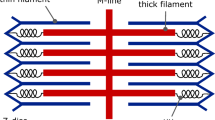Abstract
Mice exposed to intermittent hypobaric hypoxia for 20 hours a day, 6 days a week, develop extracellular adaptive responses similar to those found in humans exposed to oxygen tension equivalent to that found at an altitude of 4500 m. Isolated liver mitochondria from these animals show no significant differences in rates of substrate-stimulated respiration, ADP-stimulated respiration and the respiratory control ratio (RCR), when compared with sea level controls. Undetectable or negligible differences in these parameters are also noted when sea level animals are exposed for one hour to severe hypoxia (7% O2). We therefore conclude that the oxidative phosphorylation capacity of the isolated mouse liver mitochondria remains unaltered in both acute and chronic hypoxia. However thein vivo oxygen consumption by mice at this degree of hypoxia was markedly reduced. Lack of observable changes in oxidative phosphorylation could be accounted for by extracellular adaptations in mitochondria isolated from acclimatized animals. This explanation, however, is not consistent with the lack of changes on oxidative phosphorylation in mitochondria isolated from mice undergoing acute hypoxia at sea level. It is then suggested that isolated mitochondrial preparations are of limited value for investigating biochemical mechanisms underlying the variation of cellular respiration occurringin vivo.
Similar content being viewed by others
References
BARBASHOVA, Z. I. (1964): Cellular level of adaptation. In: Handbook of Physiology, Section 4. Adaptation to the Environment. American Physiological Society. D. B. Dill, E. F. Adolphand and C. G. Wilber (eds.), Washington D.C., 37–54.
CORREA, A. M. (1978): Un modelo de hipoxia intermitente: Estudio en ratones de algunos parametres sanguineos cerebrales. B. Sc. Thesis, Universidad Peruana Cayetano Keredia.
FRANK, L. (1982): Protection from O2 toxicity by pre-exposure to hypoxia: lung antioxidant enzyme rol. J. appl. Physiol.: Respirat. Environ. Exercise Physiol. 53: 475–482.
GOLD, A. J., JOHNSON, T. F., and COSTELLO, L. C. (1973): Effect of altitude stress on mitochondrial function. Amer. J. Physiol., 224: 946–949.
HAYASHI, M., and NAGASAKA, T. (1982): Resting metabolism in hypoxia-acclimated rats during acute hypoxic exposure. Jap. J. Physiol. 32: 487–491.
KINNULA, V. L., and HASSINEN, I. (1978): Effect of chronic hypoxia on hepatic triacylglycerol concentration and mitochondrial fatty acid oxidizing capacity in liver and heart. Acta Physiol. Scand., 102: 64–73.
LEON VELARDE, F. (1981): Neuroestimulantes y neurodepresores. Consumo de oxigeno: Efecto de la cocaina. M. Sc. Thesis, Universidad Peruana Cayetano Heredia.
MELA, L., GOODWIN, C. W. and MILLER, L. D. (1976): In vivo control of mitochondrial enzyme concentrations and activity by oxygen. Amer. J. Physiol. 231: 1811–1816.
MONGE, C.,C., WHITTEMBURY, J. (1976): The environmental physiology of animals. In: High Altitude Adaptations. Whole Animal. Blackwell Scientific, London, 287–308.
MORAN, O. (1978): Un modelo de hipoxia intermitente: Estudio morfometrico. B. Sc. Thesis, Universidad Peruana Cayetano Heredia.
MORRISON, P., and ELSNER, R. (1962): Influence of altitude on heart and breathing rates in some Peruvian rodents. J. appl. Physiol. 17: 467–470.
NELSON, B. D., HIGHMAN, B. and ALTLAND, P. D. (1967): Oxidative phosphorylation during altitude acclimation in rats. Amer. J. Physiol. 213: 1414–1418.
REYNAFARGE, C., FAURA, J., PAREDES, A. and VILLAVICENCIO, D. (1968): Erythroquinetics in high altitude adapted animals (Llama, alpaca, vicuna). J. appl. Physiol., 24: 93–97.
RIVERA, K., AGUILAR, R., BURGOS, C. and ALVAREZ, J. (1981): The oxygen consuming systems of the liver of mice exposed to simulated high altitude. Int. J. Biometeor., 25: 293–297.
ROMERO, G., NAVARRO, J., CAZORLA, A. and ALVAREZ, J. (1976): Ambient temperature and hypoxia: A differential study of liver catalase and cytochrome oxidase in guinea pig. Johns Hopkins Med. J., 139: 82–86.
SANDERS, A. P., HALE, S. M. and MILLER, A. T. Jr. (1965): Some effects of hypoxia on respiratory metabolism and protein synthesis in rat tissues. Amer. J. Physiol., 209: 443–446.
STRICKLAND, E. N., ACKERMAN, E. and ANTHONY, A. (1962): Respiration and phosphorylation in liver and heart mitochondria from altitude-exposed rats. J. Appl. Physiol., 17: 535–538.
TUREK, Z., RINGNALDA, B. E. M., MORAN, O. and KREUZER, F. (1980): Oxygen transport in guinea pigs native to high altitude (Junin, Peru, 4,105 m). Pflügers Arch., 384: 109–115.
WHITTEMBURY, J. (1983): Chronic intermittent hypoxia in mice: A high-altitude model. In: Adjustment to High Altitude. Proceedings of the International Symposium on Acclimatization, Adaptation and Tolerance to High Altitude. NIH Publication No. 83-2496, 79–82.
Author information
Authors and Affiliations
Rights and permissions
About this article
Cite this article
Leon-Velarde, F., Whittembury, J. & Monge, C. Oxidative phosphorylation of liver mitochondria from mice acclimatized to hypobaric hypoxia. Int J Biometeorol 30, 283–289 (1986). https://doi.org/10.1007/BF02189472
Received:
Issue Date:
DOI: https://doi.org/10.1007/BF02189472




